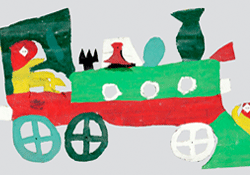African American vernacular art show to open at CCU
The exhibition, co-curated by collector George Jacobs and artist/professor Dan Powell features a variety of works by Bessie Harvey, Purvis Young, Thornton Dial Sr., David Butler, Jimmie Lee Sudduth, Mose Tolliver and Mary T. Smith.
Once ignored and marginalized by the art world with labels such as "folk art" and "outsider art," African American Vernacular art is unarguably one of the most vital creative forces in American art today, according to Cynthia Farnell, visiting art gallery director. The seven artists in this exhibit were chosen for their outstanding contributions to the movement and are widely recognized as masters of the genre.
The highlight of the exhibition will be a gallery talk on the artists and exhibition given by art historian Paul Arnett, tentatively scheduled for Thursday, Jan. 18. Arnett is the co-editor, with his father William Arnett, of the definitive study of African American Vernacular art, "Souls Grown Deep: African American Vernacular Art of the South."
Co-curator George Jacobs has been collecting self-taught and African American Vernacular Art for more than 15 years. Dan Powell is a visual artist and adjunct art professor at Salve Regina University in Newport. "This exhibit is the result of a serendipitous visit to see George Jacobs' outstanding collection," says Powell. "With George's help and the support of Cynthia Farnell and the Rebecca Randall Bryan Gallery of Art at Coastal, we have been able to put together an exciting selection of some of the most important and respected African American Vernacular artists of the past 50 years."
About the Artists:
Poet, painter, sculptor and storyteller Bessie Harvey's work grew out of a necessity to quiet the pain of a difficult and demanding life. Her gift was the ability to see and hear the inner spirit and voice of objects and to fashion them into visual form. Enchanting and mesmerizing, her expressive paintings and her sculptures, made from tree roots and found objects, are not easily forgotten.
Thornton Dial Sr.'s work is a remarkable fusion of painting, sculpture and drawing. For Dial, everything he sees or touches carries visual and expressive potential. His mixed media constructions and sculptures are oftentimes uniquely personal responses to social and political events, as well as original and compelling articulations of his own insights and ideas.
Purvis Young is a well-known local fixture in the "Overtown" section of Miami, Fla. He turned to painting while serving time in jail and draws inspiration for his work from the streets of Overtown. Young is a sharp and observant social commentator, and his work reflects his commitment to faith and community. His energetic and expressive paintings exude an intensity and immediacy unmatched in contemporary art today.
Mose Tolliver's subjects range widely from family, animals, turtles and angels, all painted with an economic palette in a direct, lyrical style. One of the first African American vernacular artists to achieve national recognition, Tolliver was deservedly considered one of the South's most influential and respected artists. The art world was saddened by his recent death on Oct.30.
David Butler's inventive constructions, critters and elaborate whirligigs fashioned from roofing tin and festooned with found objects have a bold directness and whimsical immediacy. Working with discarded materials, Butler creates a complex environment of artistic forms inspired by bible stories and populated with fanciful creatures.
Jimmie Lee Sudduth uses natural materials such as turnip leaves, roses, honey and mud to create the color and pigment for his paintings of animals, people and buildings. The son of a Native American "medicine lady," he began painting in mud at the age of three, so the story goes, and he has never stopped. The people, buildings and animals of his hometown, Fayette, Ala., populate his work, as well as Indians, sharecroppers, trains, trucks and cars.
Mary T. Smith first began decorating her yard in Hazelhurst, Miss., by hanging paintings of animals and people on her fence. Smith continued making paintings and decorating her yard until her one-acre lot became a complete comprehensive visual environment. "I did it to pretty up the place," she once said, "and to please the Lord." Simple and direct, her paintings often employ a limited palette and a simple text.
Free guided tours of the exhibition for elementary, high school and other community groups are available. Contact Farnell at cfarnell@coastal.edu or call (843) 234-3466 to make advance reservations.



